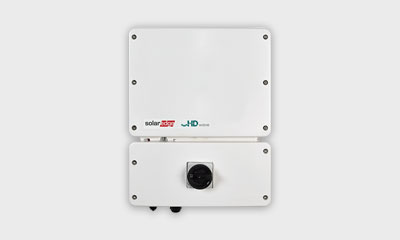

Just like we can see in the diagram below. So, that means all the rest of the hours a system will only produce at x% of the total amount. There are only a few hours a day that a solar system is producing at its maximum capacity. System output diagramĪs you know, not all hours are created equally for solar production. To really understand this, let’s look at what happens when we oversize a system. To empower the inverter to produce as much as it can, it actually makes sense to enable more DC capacity than AC. Shouldn’t we aspire to an equal amount of DC power coming as AC power going out? This would be true if panels always produced at their maximum stated output levels. On the surface, that would seem counterintuitive. Oversizing means that we have the capacity to produce more DC power in a system than the inverter can effectively turn into AC energy. What does it actually mean to oversize your system?
#SOLAREDGE INVERTER INSTALL#
When we install a system that can potentially provide more energy than the inverter can convert, it is called oversizing. In fact, installing MORE panels on a roof makes sense for many properties, but it makes particular sense for those of us living in the Northern Hemisphere, and even more so for those who live under the shy British sun. With this in mind, we would expect a recommendation to install panels to match the size of the inverter. In most cases, you will require permission to operate an inverter larger than 3.68kW, which can be a good reference number for maximum AC power.

The size allowance of the local DNO (the people who allow you to connect your PV system to their grid).Your anticipated energy usage in the future.What energy generation will look like in the future and the impact your PV system size will have on you and your property.The solar system’s power generation potential throughout the year.When installing a new solar system, one of the first questions raised is: What is the best system size for my rooftop? Or put another way: How many panels should I install? To answer these questions, we need to consider a few parameters: System sizeīefore we talk about oversizing – lets look at the bigger picture: choosing a system size. But what is oversizing? And is it really good for us?įor those of us who know for those who don’t and are afraid to ask – and for those who never heard of it before, let’s have a conversation about DC oversizing.

“Us” being specifically those of us who live in the Northern Hemisphere, and others too. Oversizing is one of those terms that people in the solar industry talk about quite a lot, and its apparently a good thing, because it’s supposed to help us take better advantage of our solar PV systems. What is the best system size to make that happen? To oversize or not to oversize… that is the question Learn more about SetApp.The best you can do for your clients and their property, is to help them generate as much power from the sun at every point of the day for the next 20, 25, 30 years. Take your inverter commissioning to the next level. Inverter commissioning is done directly through a smartphone using the intuitive SetApp mobile application. The new range of SolarEdge three phase inverters have a smart new commissioning method. This data can be transmitted to the web and accessed via the SolarEdge monitoring platform for performance analysis, fault detection and troubleshooting of PV systems.Įasy Inverter Commissioning with Inverter SetApp The fixed-voltage technology ensures the solar inverter is always working at its optimal input voltage, regardless of the number of modules in a string or environmental conditions.Ī proprietary data monitoring receiver has been integrated into the inverter and aggregates the power optimizer performance data from each PV module. The SolarEdge three phase inverter combines sophisticated digital control technology with efficient power conversion architecture to achieve superior solar power harvesting and best-in-class reliability.


 0 kommentar(er)
0 kommentar(er)
